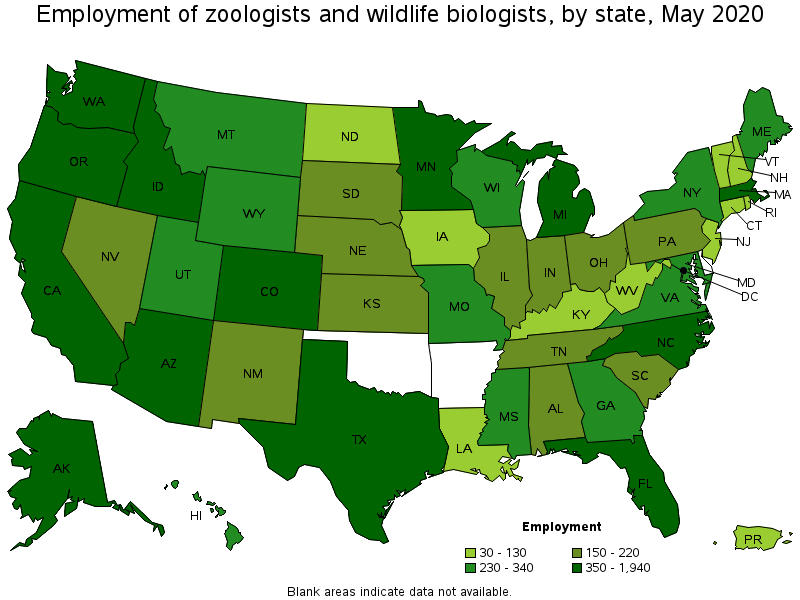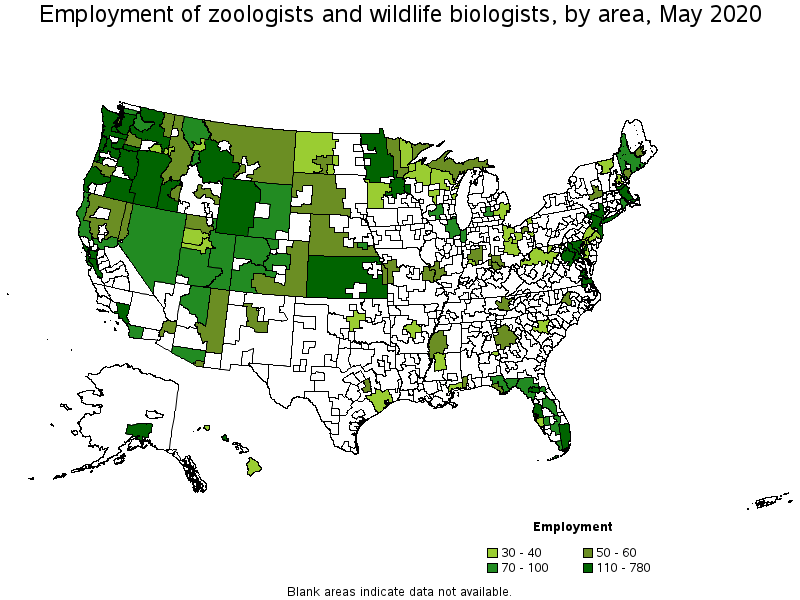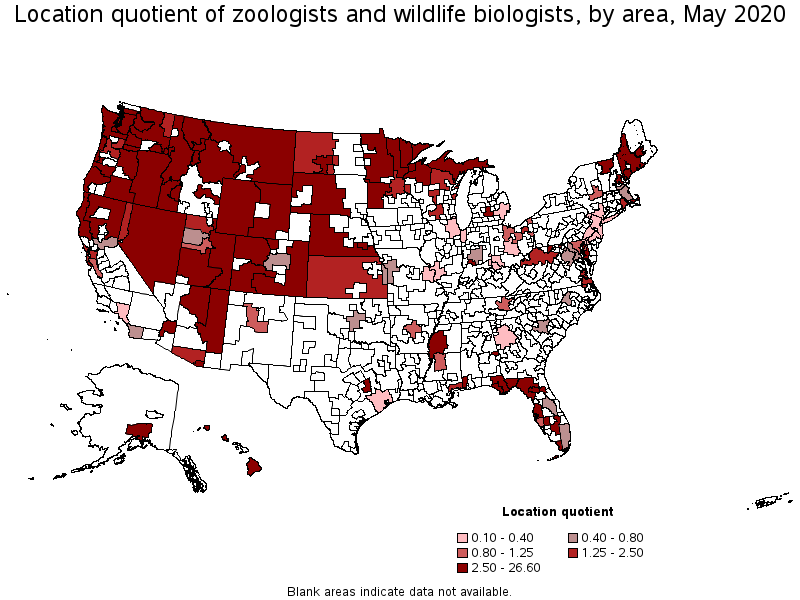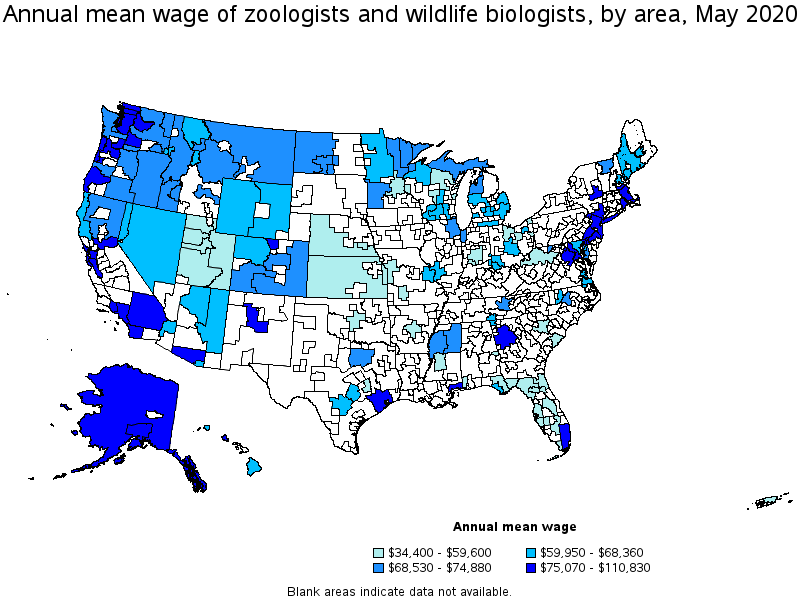An official website of the United States government
 United States Department of Labor
United States Department of Labor
Study the origins, behavior, diseases, genetics, and life processes of animals and wildlife. May specialize in wildlife research and management. May collect and analyze biological data to determine the environmental effects of present and potential use of land and water habitats.
Employment estimate and mean wage estimates for Zoologists and Wildlife Biologists:
| Employment (1) | Employment RSE (3) |
Mean hourly wage |
Mean annual wage (2) |
Wage RSE (3) |
|---|---|---|---|---|
| 17,200 | 2.1 % | $ 33.90 | $ 70,510 | 0.6 % |
Percentile wage estimates for Zoologists and Wildlife Biologists:
| Percentile | 10% | 25% | 50% (Median) |
75% | 90% |
|---|---|---|---|---|---|
| Hourly Wage | $ 20.06 | $ 25.31 | $ 31.90 | $ 39.74 | $ 51.12 |
| Annual Wage (2) | $ 41,720 | $ 52,630 | $ 66,350 | $ 82,670 | $ 106,320 |
Industries with the highest published employment and wages for Zoologists and Wildlife Biologists are provided. For a list of all industries with employment in Zoologists and Wildlife Biologists, see the Create Customized Tables function.
Industries with the highest levels of employment in Zoologists and Wildlife Biologists:
| Industry | Employment (1) | Percent of industry employment | Hourly mean wage | Annual mean wage (2) |
|---|---|---|---|---|
| State Government, excluding schools and hospitals (OEWS Designation) | 7,110 | 0.32 | $ 29.38 | $ 61,120 |
| Federal Executive Branch (OEWS Designation) | 3,860 | 0.19 | $ 42.49 | $ 88,390 |
| Management, Scientific, and Technical Consulting Services | 1,630 | 0.11 | $ 34.67 | $ 72,110 |
| Local Government, excluding schools and hospitals (OEWS Designation) | 1,210 | 0.02 | $ 36.15 | $ 75,190 |
| Colleges, Universities, and Professional Schools | 850 | 0.03 | $ 33.68 | $ 70,050 |
Industries with the highest concentration of employment in Zoologists and Wildlife Biologists:
| Industry | Employment (1) | Percent of industry employment | Hourly mean wage | Annual mean wage (2) |
|---|---|---|---|---|
| Museums, Historical Sites, and Similar Institutions | 570 | 0.39 | $ 27.55 | $ 57,310 |
| Social Advocacy Organizations | 720 | 0.33 | $ 27.10 | $ 56,360 |
| State Government, excluding schools and hospitals (OEWS Designation) | 7,110 | 0.32 | $ 29.38 | $ 61,120 |
| Federal Executive Branch (OEWS Designation) | 3,860 | 0.19 | $ 42.49 | $ 88,390 |
| Management, Scientific, and Technical Consulting Services | 1,630 | 0.11 | $ 34.67 | $ 72,110 |
Top paying industries for Zoologists and Wildlife Biologists:
| Industry | Employment (1) | Percent of industry employment | Hourly mean wage | Annual mean wage (2) |
|---|---|---|---|---|
| Federal Executive Branch (OEWS Designation) | 3,860 | 0.19 | $ 42.49 | $ 88,390 |
| Architectural, Engineering, and Related Services | 250 | 0.02 | $ 38.70 | $ 80,490 |
| Scientific Research and Development Services | 680 | 0.09 | $ 37.79 | $ 78,610 |
| Local Government, excluding schools and hospitals (OEWS Designation) | 1,210 | 0.02 | $ 36.15 | $ 75,190 |
| Management, Scientific, and Technical Consulting Services | 1,630 | 0.11 | $ 34.67 | $ 72,110 |
States and areas with the highest published employment, location quotients, and wages for Zoologists and Wildlife Biologists are provided. For a list of all areas with employment in Zoologists and Wildlife Biologists, see the Create Customized Tables function.

States with the highest employment level in Zoologists and Wildlife Biologists:
| State | Employment (1) | Employment per thousand jobs | Location quotient (9) | Hourly mean wage | Annual mean wage (2) |
|---|---|---|---|---|---|
| Washington | 1,940 | 0.61 | 4.90 | $ 39.41 | $ 81,960 |
| California | 1,630 | 0.10 | 0.80 | $ 39.19 | $ 81,520 |
| Florida | 1,580 | 0.19 | 1.51 | $ 25.53 | $ 53,100 |
| Oregon | 880 | 0.49 | 3.94 | $ 37.07 | $ 77,100 |
| Alaska | 730 | 2.47 | 19.96 | $ 38.92 | $ 80,950 |

States with the highest concentration of jobs and location quotients in Zoologists and Wildlife Biologists:
| State | Employment (1) | Employment per thousand jobs | Location quotient (9) | Hourly mean wage | Annual mean wage (2) |
|---|---|---|---|---|---|
| Alaska | 730 | 2.47 | 19.96 | $ 38.92 | $ 80,950 |
| Wyoming | 260 | 0.97 | 7.88 | $ 31.00 | $ 64,490 |
| Montana | 340 | 0.74 | 6.01 | $ 32.73 | $ 68,070 |
| Washington | 1,940 | 0.61 | 4.90 | $ 39.41 | $ 81,960 |
| Idaho | 380 | 0.53 | 4.29 | $ 33.38 | $ 69,430 |

Top paying states for Zoologists and Wildlife Biologists:
| State | Employment (1) | Employment per thousand jobs | Location quotient (9) | Hourly mean wage | Annual mean wage (2) |
|---|---|---|---|---|---|
| District of Columbia | 90 | 0.12 | 1.01 | $ 54.48 | $ 113,310 |
| Massachusetts | 370 | 0.11 | 0.88 | $ 45.37 | $ 94,380 |
| New Jersey | 110 | 0.03 | 0.24 | $ 40.35 | $ 83,920 |
| Hawaii | 270 | 0.46 | 3.75 | $ 40.02 | $ 83,250 |
| Maryland | 330 | 0.13 | 1.04 | $ 39.93 | $ 83,050 |

Metropolitan areas with the highest employment level in Zoologists and Wildlife Biologists:
| Metropolitan area | Employment (1) | Employment per thousand jobs | Location quotient (9) | Hourly mean wage | Annual mean wage (2) |
|---|---|---|---|---|---|
| Seattle-Tacoma-Bellevue, WA | 780 | 0.40 | 3.21 | $ 42.74 | $ 88,900 |
| San Francisco-Oakland-Hayward, CA | 520 | 0.22 | 1.80 | $ 37.71 | $ 78,440 |
| Tampa-St. Petersburg-Clearwater, FL | 510 | 0.39 | 3.17 | $ 25.01 | $ 52,020 |
| Minneapolis-St. Paul-Bloomington, MN-WI | 340 | 0.18 | 1.47 | $ 26.90 | $ 55,950 |
| Olympia-Tumwater, WA | 290 | 2.62 | 21.19 | $ 36.00 | $ 74,880 |
| Washington-Arlington-Alexandria, DC-VA-MD-WV | 270 | 0.09 | 0.72 | $ 50.08 | $ 104,160 |
| Portland-Vancouver-Hillsboro, OR-WA | 270 | 0.24 | 1.91 | $ 41.26 | $ 85,830 |
| Anchorage, AK | 210 | 1.30 | 10.49 | $ 36.95 | $ 76,860 |
| Urban Honolulu, HI | 210 | 0.51 | 4.12 | $ 42.40 | $ 88,190 |
| Miami-Fort Lauderdale-West Palm Beach, FL | 200 | 0.08 | 0.65 | $ 36.31 | $ 75,520 |

Metropolitan areas with the highest concentration of jobs and location quotients in Zoologists and Wildlife Biologists:
| Metropolitan area | Employment (1) | Employment per thousand jobs | Location quotient (9) | Hourly mean wage | Annual mean wage (2) |
|---|---|---|---|---|---|
| Corvallis, OR | 120 | 3.29 | 26.60 | $ 36.99 | $ 76,930 |
| Olympia-Tumwater, WA | 290 | 2.62 | 21.19 | $ 36.00 | $ 74,880 |
| Mount Vernon-Anacortes, WA | 100 | 2.23 | 18.07 | $ 37.70 | $ 78,410 |
| Wenatchee, WA | 80 | 1.68 | 13.58 | $ 37.38 | $ 77,740 |
| Barnstable Town, MA | 130 | 1.44 | 11.62 | $ 50.91 | $ 105,890 |
| Lewiston, ID-WA | 40 | 1.35 | 10.90 | $ 29.42 | $ 61,190 |
| Anchorage, AK | 210 | 1.30 | 10.49 | $ 36.95 | $ 76,860 |
| Flagstaff, AZ | 70 | 1.27 | 10.25 | $ 29.46 | $ 61,290 |
| Walla Walla, WA | 30 | 1.22 | 9.90 | $ 32.95 | $ 68,530 |
| Bangor, ME | 60 | 1.03 | 8.36 | $ 30.77 | $ 64,000 |

Top paying metropolitan areas for Zoologists and Wildlife Biologists:
| Metropolitan area | Employment (1) | Employment per thousand jobs | Location quotient (9) | Hourly mean wage | Annual mean wage (2) |
|---|---|---|---|---|---|
| Gulfport-Biloxi-Pascagoula, MS | 30 | 0.23 | 1.88 | $ 53.28 | $ 110,830 |
| San Diego-Carlsbad, CA | 80 | 0.06 | 0.45 | $ 52.25 | $ 108,680 |
| Barnstable Town, MA | 130 | 1.44 | 11.62 | $ 50.91 | $ 105,890 |
| Washington-Arlington-Alexandria, DC-VA-MD-WV | 270 | 0.09 | 0.72 | $ 50.08 | $ 104,160 |
| San Jose-Sunnyvale-Santa Clara, CA | 140 | 0.13 | 1.06 | $ 44.59 | $ 92,750 |
| Boston-Cambridge-Nashua, MA-NH | 160 | 0.06 | 0.49 | $ 44.48 | $ 92,520 |
| Houston-The Woodlands-Sugar Land, TX | 40 | 0.01 | 0.10 | $ 44.13 | $ 91,780 |
| Bellingham, WA | (8) | (8) | (8) | $ 43.54 | $ 90,560 |
| Seattle-Tacoma-Bellevue, WA | 780 | 0.40 | 3.21 | $ 42.74 | $ 88,900 |
| New York-Newark-Jersey City, NY-NJ-PA | 180 | 0.02 | 0.17 | $ 42.43 | $ 88,260 |
Nonmetropolitan areas with the highest employment in Zoologists and Wildlife Biologists:
| Nonmetropolitan area | Employment (1) | Employment per thousand jobs | Location quotient (9) | Hourly mean wage | Annual mean wage (2) |
|---|---|---|---|---|---|
| Coast Oregon nonmetropolitan area | 180 | 1.74 | 14.07 | $ 36.79 | $ 76,530 |
| Western Washington nonmetropolitan area | 160 | 1.39 | 11.22 | $ 35.56 | $ 73,970 |
| Western Wyoming nonmetropolitan area | 140 | 1.43 | 11.59 | $ 32.13 | $ 66,830 |
| Northwest Minnesota nonmetropolitan area | 130 | 0.74 | 6.01 | $ 32.86 | $ 68,360 |
| Eastern Washington nonmetropolitan area | 120 | 1.34 | 10.84 | $ 34.77 | $ 72,320 |
Nonmetropolitan areas with the highest concentration of jobs and location quotients in Zoologists and Wildlife Biologists:
| Nonmetropolitan area | Employment (1) | Employment per thousand jobs | Location quotient (9) | Hourly mean wage | Annual mean wage (2) |
|---|---|---|---|---|---|
| Central Oregon nonmetropolitan area | 110 | 1.96 | 15.86 | $ 33.47 | $ 69,620 |
| Coast Oregon nonmetropolitan area | 180 | 1.74 | 14.07 | $ 36.79 | $ 76,530 |
| Eastern Oregon nonmetropolitan area | 120 | 1.68 | 13.59 | $ 34.85 | $ 72,490 |
| Northeast Minnesota nonmetropolitan area | 60 | 1.44 | 11.62 | $ 33.74 | $ 70,170 |
| Western Wyoming nonmetropolitan area | 140 | 1.43 | 11.59 | $ 32.13 | $ 66,830 |
Top paying nonmetropolitan areas for Zoologists and Wildlife Biologists:
| Nonmetropolitan area | Employment (1) | Employment per thousand jobs | Location quotient (9) | Hourly mean wage | Annual mean wage (2) |
|---|---|---|---|---|---|
| Alaska nonmetropolitan area | (8) | (8) | (8) | $ 40.76 | $ 84,770 |
| Coast Oregon nonmetropolitan area | 180 | 1.74 | 14.07 | $ 36.79 | $ 76,530 |
| Southwest Colorado nonmetropolitan area | 80 | 0.85 | 6.84 | $ 35.67 | $ 74,200 |
| Western Washington nonmetropolitan area | 160 | 1.39 | 11.22 | $ 35.56 | $ 73,970 |
| Northeast Mississippi nonmetropolitan area | (8) | (8) | (8) | $ 35.28 | $ 73,390 |
These estimates are calculated with data collected from employers in all industry sectors, all metropolitan and nonmetropolitan areas, and all states and the District of Columbia. The top employment and wage figures are provided above. The complete list is available in the downloadable XLS files.
The percentile wage estimate is the value of a wage below which a certain percent of workers fall. The median wage is the 50th percentile wage estimate—50 percent of workers earn less than the median and 50 percent of workers earn more than the median. More about percentile wages.
(1) Estimates for detailed occupations do not sum to the totals because the totals include occupations not shown separately. Estimates do not include self-employed workers.
(2) Annual wages have been calculated by multiplying the hourly mean wage by a "year-round, full-time" hours figure of 2,080 hours; for those occupations where there is not an hourly wage published, the annual wage has been directly calculated from the reported survey data.
(3) The relative standard error (RSE) is a measure of the reliability of a survey statistic. The smaller the relative standard error, the more precise the estimate.
(8) Estimate not released.
(9) The location quotient is the ratio of the area concentration of occupational employment to the national average concentration. A location quotient greater than one indicates the occupation has a higher share of employment than average, and a location quotient less than one indicates the occupation is less prevalent in the area than average.
Other OEWS estimates and related information:
May 2020 National Occupational Employment and Wage Estimates
May 2020 State Occupational Employment and Wage Estimates
May 2020 Metropolitan and Nonmetropolitan Area Occupational Employment and Wage Estimates
May 2020 National Industry-Specific Occupational Employment and Wage Estimates
Last Modified Date: March 31, 2021